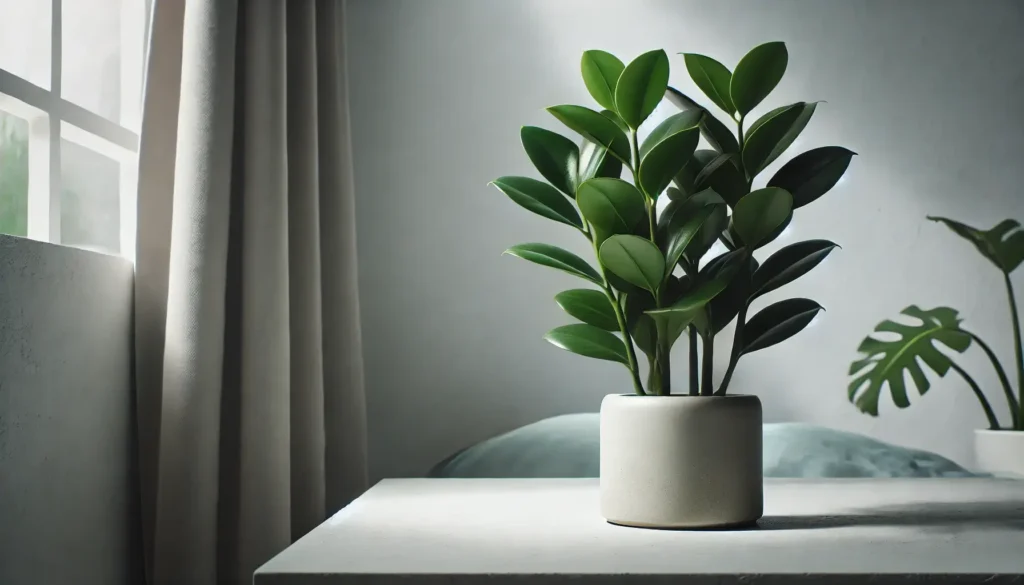The ZZ plant (Zamioculcas zamiifolia) is a highly popular choice for indoor gardeners due to its ability to withstand neglect and thrive in various conditions. Its low-maintenance nature makes it perfect for beginners or those with busy schedules who still want a beautiful, resilient houseplant.
ZZ Plant Overview
- Scientific Name: Zamioculcas zamiifolia
- Common Names: ZZ plant, Zanzibar gem, eternity plant
- Origin: Eastern Africa (Kenya, Tanzania, Zanzibar)
- Family: Araceae (Arum family)
- Light: Low to bright indirect light; can tolerate low light
- Watering: Water thoroughly when the soil is dry. Avoid overwatering.
- Temperature: 65°F – 80°F (18°C – 27°C)
- Toxicity: Toxic to pets and humans if ingested
How to Propagate a ZZ Plant
ZZ plants can be propagated through various methods, including stem cuttings and leaf cuttings. Both methods take time and patience, but they can be highly rewarding for plant enthusiasts.
Steps for Propagating a ZZ Plant:
1. Stem Cuttings:
- Take a cutting: Cut a healthy stem from a mature ZZ plant. Make sure the cutting has a few leaves attached. (source)
- Allow to dry: Let the cut end of the stem dry for a day or two to form a callous.
- Plant in soil: Plant the cutting in a well-draining potting mix, such as one designed for succulents or cactus. (source)
- Water sparingly: Water the cutting lightly, making sure the soil remains barely moist.
- Be patient: ZZ plant cuttings can take several months to develop roots. Keep the plant in indirect light during this time. (source)
2. Leaf Cuttings:
- Select a healthy leaf: Choose a mature and healthy leaf from the plant. (source)
- Allow to dry: Let the cut end of the leaf dry out for a day or two.
- Place in soil: Insert the bottom part of the leaf into a well-draining potting mix.
- Water lightly: Keep the soil slightly moist, ensuring it does not become soggy.
- Be patient: Rooting can take several months, and instead of direct roots, you may sometimes see small plantlets form at the base of the leaf. (source)
ZZ Plant Care Guide
ZZ plants are known for their adaptability and resilience, making them a great option for any indoor setting. Here’s how to care for them:
- Light: ZZ plants tolerate low light but prefer bright, indirect light for optimal growth. Avoid direct sunlight, which can burn the leaves. (source)
- Watering: These plants are drought-tolerant and prefer to dry out completely between waterings. Water thoroughly when the soil is dry, but be cautious of overwatering, as it can lead to root rot. (source)
- Soil: Use a well-draining potting mix, such as cactus or succulent soil. ZZ plants do not like sitting in wet soil. (source)
- Temperature: Maintain an average household temperature between 65°F and 80°F (18°C – 27°C). Avoid placing the plant in cold drafts or next to heating vents. (source)
- Fertilizer: While ZZ plants don’t need heavy feeding, they can benefit from a diluted balanced liquid fertilizer during the growing season (spring and summer). (source)
- Repotting: Repot every 2-3 years or when the plant becomes root-bound. Use a pot that is slightly larger than the current one to encourage growth. (source)
- Pests: ZZ plants are generally pest-resistant but can occasionally be affected by pests like spider mites or aphids. Check the plant regularly and wipe the leaves to keep them clean. (source)
Troubleshooting Common ZZ Plant Problems
- Yellowing Leaves: The most common cause of yellowing leaves is overwatering. Make sure the soil is completely dry before watering again. (source)
- Drooping Leaves: This can indicate either underwatering or too much direct sunlight. Adjust the plant’s water intake or move it to a shadier spot if needed. (source)
- Brown Leaf Tips: This may be caused by low humidity or dry soil. Make sure the plant is not too close to a draft and that it is being watered regularly. (source)
ZZ Plant and Air Purification
Like many other houseplants, ZZ plants contribute to better indoor air quality by filtering out toxins such as xylene, toluene, and benzene. While the ZZ plant is not the most effective plant in NASA’s air-cleaning study, it still offers some level of purification. (source)
Conclusion
The ZZ plant is an excellent choice for anyone seeking a low-maintenance, visually appealing houseplant.
Whether you’re a beginner or have a busy schedule, this resilient and adaptable plant can thrive in your home with minimal effort.
Its tolerance to low light and drought make it one of the best choices for indoor spaces.

